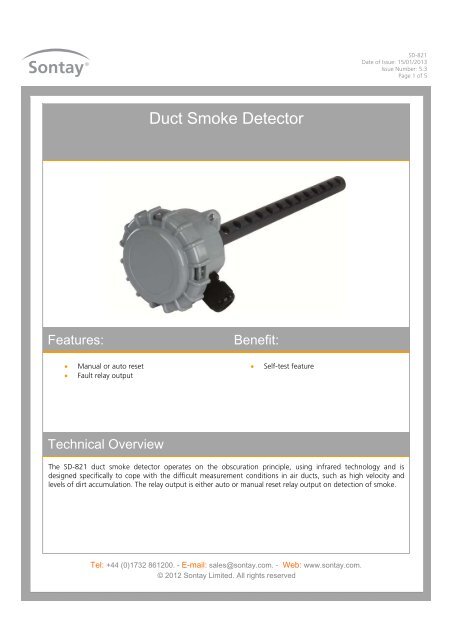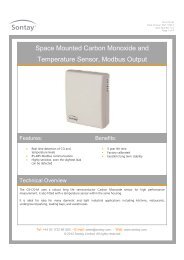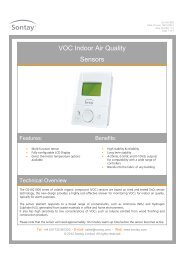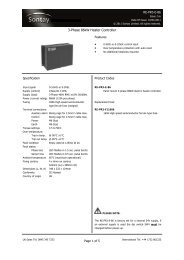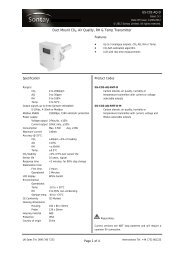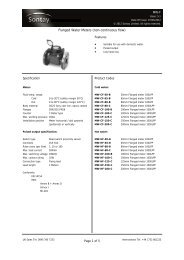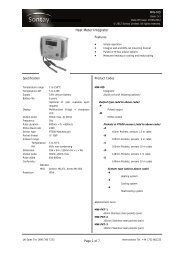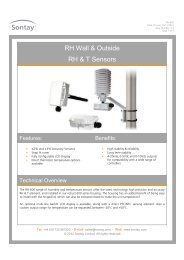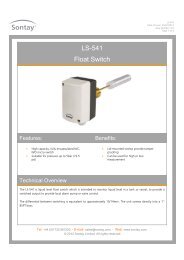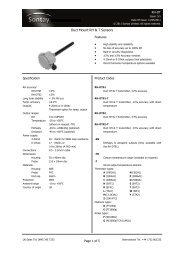You also want an ePaper? Increase the reach of your titles
YUMPU automatically turns print PDFs into web optimized ePapers that Google loves.
SD-821<br />
Date of Issue: 15/01/2013<br />
Issue Number: 5.3<br />
Page 1 of 5<br />
<strong>Duct</strong> <strong>Smoke</strong> <strong>Detector</strong><br />
Features:<br />
Benefit:<br />
<br />
<br />
Manual or auto reset<br />
Fault relay output<br />
<br />
Self-test feature<br />
Technical Overview<br />
The SD-821 duct smoke detector operates on the obscuration principle, using infrared technology and is<br />
designed specifically to cope with the difficult measurement conditions in air ducts, such as high velocity and<br />
levels of dirt accumulation. The relay output is either auto or manual reset relay output on detection of smoke.<br />
Tel: +44 (0)1732 861200. - E-mail: sales@sontay.com. - Web: www.sontay.com.<br />
© 2012 <strong>Sontay</strong> Limited. All rights reserved
SD-821<br />
Date of Issue: 15/01/2013<br />
Issue Number: 5.3<br />
Page 2 of 5<br />
Specification:<br />
Part Codes:<br />
Supply 24Vac/dc, ±20%<br />
Power consumption 50mA max.<br />
Relay outputs (smoke & fault)<br />
SPST 2A @ 48V<br />
Minimum duct size 100 x 320mm (3.94 x 12.60”)<br />
Maximum duct size 450 x 450mm*<br />
(17.72 x 17.72”)*<br />
LED indication<br />
ON in alarm<br />
Alarm relay (selectable) Manual or auto reset<br />
Housing:<br />
Material ABS (flame retardant type VO)<br />
Dimensions 55mm x 90mm dia.<br />
(2.17 x 3.54”)<br />
Probe:<br />
Dimensions 300 x 20mm dia.<br />
(11.81 x 0.79”)<br />
Material Plastic<br />
Protection<br />
IP65 (housing only)<br />
Ambient range:<br />
Temperature +10 to 40°C (50 to 104°F)<br />
RH<br />
20 to 80% non-condensing<br />
Country of origin Denmark<br />
SD-821<br />
<strong>Duct</strong> smoke detector<br />
The products referred to in this data sheet meet the<br />
requirements of EU Directive 2004/108/EC<br />
* Please see recommendations on page 3.<br />
Tel: +44 (0)1732 861200. - E-mail: sales@sontay.com. - Web: www.sontay.com.<br />
© 2012 <strong>Sontay</strong> Limited. All rights reserved
SD-821<br />
Date of Issue: 15/01/2013<br />
Issue Number: 5.3<br />
Page 3 of 5<br />
How It Works:<br />
The sensor works by using an infra-red transmitter and receiver fitted to the PCB inside of the housing. The transmitting<br />
device sends a beam, which is reflected from a mirror in the end of the 300mm long probe, and the receiving device then<br />
receives this beam when there are no obstacles, like smoke partials in the tube. If smoke is present, then this will disturb the<br />
beam, and the receiver will lose the signal and an alarm will be activated.<br />
On power up the SD-821 will start an automatic calibration procedure, the power from the TX device will increase in small<br />
steps, just until the RX device receives enough signal to validate the “link”. This is stored in the volatile memory for any<br />
further use, or until a new power on. Now any obstacles, like smoke will force an alarm.<br />
Recommendations<br />
<br />
<br />
<br />
<br />
<br />
<br />
The SD-821 has a probe length of 300mm and should NOT be used in ducts with a diameter or square size greater<br />
than 450mm, unless the smoke detection is intended as a secondary non-life safety action with areas served being<br />
covered by smoke detection connected to a fire alarm system that is able to shut-off the ventilation fans, as it will<br />
not monitor the whole of the duct.<br />
Units should NOT be mounted where ambient sunlight will fall on the photocell.<br />
Units should never be mounted at or near sharp bends in ductwork, as turbulence and side currents can carry the<br />
smoke away from the probe.<br />
The SD-821 is an optical beam detector and therefore, air velocity has little effect on performance. However, careful<br />
positioning of the detector is required if optimum detection is to be achieved. The detector should always be fitted<br />
with the holes in the sensing tube parallel to the airflow.<br />
Units should not be mounted close to supply or extract fans.<br />
With large installations, where several ducts collect into a common duct, consideration must be given to dilution of<br />
smoke and rate of airflow. For example, 10 small ducts may feed at different points into one large main extract<br />
duct, and if only one smoke detector is fitted in the main extract duct, the position can arise where one duct is<br />
feeding smoke and nine are feeding clean air. The amount of smoke is therefore diluted by 90%, and if this is<br />
coupled with a high flow rate, the smoke may not be detected for the minimum operating period of 1 second,<br />
resulting in no alarm being generated. It may be necessary to mount 10 detectors in each of the small ducts to<br />
guarantee correct operation.<br />
Reset Modes:<br />
The SD-821 is factory set as manual reset on alarm or fault, to change modes;<br />
Auto reset<br />
Manual reset<br />
Press and hold the PCB mounted button for approx. 5 seconds, the internal LED will change from green to<br />
red. After approx. 5 seconds, the LED will go off for 1 second. Release the PCB mounted button. The<br />
device is now in auto reset mode and the LED will be continuously lit green.<br />
Press and hold the PCB mounted button for approx. 5 seconds, the internal LED will change from green to<br />
red. After approx. 5 seconds, the LED will go orange for 1 second. Release the PCB mounted button. The<br />
device is now in manual reset mode and the LED will be continuously lit green.<br />
Tel: +44 (0)1732 861200. - E-mail: sales@sontay.com. - Web: www.sontay.com.<br />
© 2012 <strong>Sontay</strong> Limited. All rights reserved
SD-821<br />
Date of Issue: 15/01/2013<br />
Issue Number: 5.3<br />
Page 4 of 5<br />
Calibration & Alarm Condition:<br />
While the detector is auto-calibrating, the internal LED will flash red 6 times a second. When calibration is finished, the LED<br />
will change to orange for a few seconds, the calibration is being stored in the volatile memory.<br />
The LED will then be continuously lit green, this also indicates that the sensor is powered correctly and not in alarm.<br />
If the detector is in alarm or a fault has occurred, the internal LED will change to red and the external LED will change to<br />
yellow.<br />
Under normal operating conditions the relay is energised. Therefore, if any fault develops the relay will de-energise shutting<br />
off the equipment connected to the relay, i.e burner or circulating fan, rendering the installation safe.<br />
Relay status<br />
Un-powered Open<br />
Powered Closed<br />
Alarm Open<br />
Installation:<br />
1. The SD-821 should only be installed by a competent, suitably trained technician, experienced in installation with<br />
hazardous voltages. (>50Vac & 75Vdc & 1500Vdc)<br />
2. Ensure that all power is disconnected before carrying out any work on the SD-821.<br />
3. If the sensor is mounted outside, it is recommended that the unit be mounted with the cable entry at the bottom. If<br />
the cable is fed from above then into the cable gland at the bottom, it is recommended that a rain loop be placed<br />
in the cable before entry into the sensor.<br />
4. Drill a 22mm (0.87”) diameter hole, make sure to align the holes in the probe so that they point into the air flow,<br />
not at right angles to it. Drill two holes at 85mm (3.35”) centres and fix the IP65 housing to the duct with<br />
appropriate screws.<br />
5. Remove the front cover by twisting the lid and separating from the main body.<br />
6. Feed the cable through the waterproof gland and terminate the cores at the terminal block. Leaving some slack<br />
inside the unit, tighten the cable gland onto the cable to ensure water tightness.<br />
7. Maximum cable is 2.5mm², care must be taken not to over tighten terminals.<br />
8. Ensure the supply voltage is within the specified tolerances.<br />
9. Replace the lid tightly.<br />
Tel: +44 (0)1732 861200. - E-mail: sales@sontay.com. - Web: www.sontay.com.<br />
© 2012 <strong>Sontay</strong> Limited. All rights reserved
SD-821<br />
Date of Issue: 15/01/2013<br />
Issue Number: 5.3<br />
Page 5 of 5<br />
Connections:<br />
1. Fault Output Common<br />
2. Fault Output Normally Closed*<br />
3. <strong>Smoke</strong> Detection Output Common<br />
4. <strong>Smoke</strong> Detection Output Normally Closed*<br />
5. Supply +24Vac/dc, ±20%<br />
6. Supply 0V<br />
1 2 3 4 5 6<br />
COM NC COM NC +IN GND<br />
RELAY<br />
OUT<br />
RELAY<br />
OUT<br />
SUPPLY<br />
IN<br />
* See alarm conditions on page 4<br />
TEST<br />
Test & Reset<br />
button<br />
LED<br />
Self-Test, Failure Mode & Manual Reset:<br />
The output of the SD-821 can be manually overridden, to check integrity of the field wiring.<br />
Press the PCB mounted button for no more than 4 seconds, otherwise it change the reset mode function. In test mode both<br />
relay outputs will open, the external led will be yellow and the internal LED red.<br />
The external LED will flash red if the detector fails.<br />
Manual reset button<br />
Whilst every effort has been made to ensure the accuracy of this specification, <strong>Sontay</strong> cannot accept responsibility for damage, injury,<br />
loss or expense from errors or omissions. In the interest of technical improvement, this specification may be altered without notice.<br />
Tel: +44 (0)1732 861200. - E-mail: sales@sontay.com. - Web: www.sontay.com.<br />
© 2012 <strong>Sontay</strong> Limited. All rights reserved


